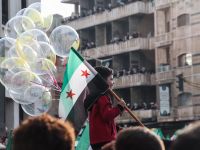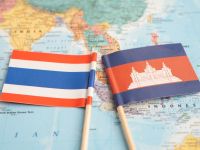When non-violent demonstrations broke out in the southern Syrian city of Daraa in March 2011, no one could have imagined the bloody aftermath that was to follow.
Today, rebel groups wrestle with Daesh (ISIS) fighters and Syrian government forces for control of strategic points across the country, while the international community mulls whom to arm and where to target airstrikes. Meanwhile, the Assad regime shows no signs of leaving.
Syria’s modern battlefield leaves nothing black and white.
How many people have died so far in the war? Even that depends on who you ask.
The death toll stood at 215,518 on the conflict’s four-year anniversary on March 15, according to the monitoring group Syrian Observatory for Human Rights. A shocking figure, and one reported by a myriad of major media outlets. Reuters, BBC, The New York Times, AFP — almost all of our most reliable news sources use this figure. In reality, we know next to nothing about the Observatory’s methods.
And other groups have given different numbers. Syria Tracker’s latest figure: 120,442; Syrian Shuhada: 125,131.
The discrepancy in numbers — and concerns over reliability — are reminders that no one really knows exactly how many people have been killed. This was never more evident than in January of last year, when the UN temporarily stopped updating the death toll of the Syria conflict, admitting its worries over the accuracy of the numbers given by different sources. Although it has since restarted counting, its actions demonstrate the sheer complexity and dilemmas of recording the fallen.
Who’s counting?
NGOS, hospitals and monitoring groups started recording the fatalities when anti-government protests became deadly in 2011. As tensions tumbled into full-blown conflict, many people who had been tallying the data fled. What was left were those who didn’t want to leave their home country, or simply couldn’t. They continued to document the chaos, clinging to an optimism that the international community might help them.
Many groups formed just weeks or months into the conflict, like the Syrian Network for Human Rights (SNHR), the Syrian Observatory for Human Rights (SOHR), the Violations Documentation Center (VDC) and the Syrian Center for Statistics and Research (SCSR). They usually describe themselves as “independent” or “neutral,” but most are seen as supporting the opposition.
The groups are based outside Syria but use data from activists inside the country. Others, like Syrian Shuhada, don’t have anyone on the ground, instead merging data from a variety of online sources.
Trusting and verifying
Media outlets know all too well how difficult the numbers can be to authenticate.
The mantra has punctuated the Syrian conflict: “The BBC has not been able to fully authenticate this footage” or “The Observatory's [SOHR] toll could not be independently verified by Reuters.”
SNHR says it relies on “the most credible activists” while the SJAC states “documentation is collected from trusted individuals and organizations from all over Syria.” Other groups give similar strategies, striving to give reassurance about the reliability of their information.
But how do groups know which people on the ground to trust?

Run by Abdul Rahman, a Syrian national who fled to the UK years ago, the SOHR is based in Coventry but gets its figures from the ground. Rahman told reporters he spends hours talking to activists within Syria, where four men work for him pulling information from a wide net of sources to boost accuracy.
“We have over 230 Syrians on the ground working with us and we communicate with them via phone, Skype, Facebook and WhatsApp. We never use information based on one source, but cross-verify,” the director told The World Post last year.
Perhaps the most well-known and its numbers the most quoted by major news organizations, the Observatory’s death toll figure is also the highest of the groups.
Yet as the VDC’s spokesman, Bassam al-Ahmad notes: “The Observatory publishes numbers from all sides, including regime fatalities.” This is one reason he gives for the high number. Another is their methodology, which is difficult to verify as the process is not shared publicly.
VDC processes are more transparent, with a lowdown of aims and methodologies listed on the group’s website. It relies on a number of sources spanning local imams, field hospitals, cemeteries and victims’ families to give information to a team of reporters throughout Syria.
Similarly, the SJAC has come to rely on regular sources. “Our staff are local in their communities and they know who is credible and trusted and who is not. We don't accept information from ‘anyone,” Mohammad al Abdallah, SJAC’s executive director, told Al Bawaba.
Syria’s volatile battlefield makes it much more difficult to get credible information than when the conflict started in 2011. “We were all inside Syria at the start. There were so many people working as activists or for Local Coordination Committees and everyone was doing their part,” Bassam explained.
Since 2014, vastly diverging reports of the same event have been on the rise. Some people might say a massacre hasn’t happened, while others give a tally of those killed.
The VDC director said they’ve learned to view each claim with some skepticism. “We hear a lot about killings and attacks, but when we check the information we realize it isn’t real,” Bassam said.
He isn’t sure why people make things up, but suggests it may be to do with political agendas and may now be a “tool of war.”
Groups reply on a number of different tools to boost accuracy; from cross-referencing social media accounts and YouTube videos, to training counters how to properly document death tolls.
The SJAC has produced a manual for those documenting human rights abuses in Syria. It states the importance of direct evidence, such as eyewitness accounts, but also indirect evidence that may confirm the event in question, like bullet casings or bomb fragments found near a victim’s home. It also gives advice on the type of questions to ask to ascertain the perpetrators, such as descriptions of uniforms or types of attacks.
The efforts aren’t foolproof, but groups say they can help to ensure death tolls are as accurate and complete as possible.
Data science and crowdsourcing
As the conflict deepens, the methods to monitor it have become more sophisticated.
HDRAG, a group of German and American scientists working with Syrians, uses rigorous statistical analysis from data sets of different documentation groups such as the VDC and SNHR to break down the Syrian conflict.
Crowdsourcing has also been a popular and necessary method used by monitors to obtain information, photos and footage. But problems of accuracy still crop up. Syria Tracker says it only uses about 6 percent of ground reports it receives, since many can’t be verified.
Meanwhile, some mainstream media organizations, like The Guardian, worry using the material may put the contributing source at risk. Syria is now considered the most dangerous place in the world to be a journalist, according to the Committee to Protect Journalists (CPJ), so media outlets are even less likely to send their own employees into the minefield.
An organization launched just weeks into the conflict, Syria Tracker encourages its civilian reporters to contribute anonymously, using encryption software. With the exception of government controlled SMS messages, citizens on the ground can submit reports through its website, email or Twitter.
The group regularly sifts through 2,000 sources spanning news reports and tweets from across Syria, including pro-government ones, trying to authenticate the data.
The uncounted
Violence is happening on such a large scale throughout the country that many deaths go undocumented. While numerous activists may report on one large event where it is easier to count the number of people who have died, there are many violence-prone areas that are incredibly difficult to access.
Then there are areas run by Islamist groups, who don’t share their death and casualty figures. VDC says there are still some activists documenting violations secretly in Daesh-controlled areas such as Raqqa, like the group Raqqa Is Being Slaughtered Silently, but that they are few and far between.
In February, SOHR recorded that 4,075 people had died. Of these, 832 were civilians and 1,265 were non-Syrians. The monitor warned that the real number of non-Syrian deaths from pro-regime fighters and militant groups is likely much higher due to the difficulty getting accurate numbers from inside regime and Daesh jails.
Mohammad Al Abdallah, from the SJAC says: “Security is the biggest challenge. We have lots of great activists, either killed, imprisoned, or forced to leave the country.” The numbers of those trusted to give information has dwindled, and groups are forced to search for new people.
Even the VDC’s founder Razan Zaitouneh was abducted in Douma in December 2013, along with three other members of the group. There has been no information on them since. Because of such disappearances, other activists who would give information do not. Many are earful of repercussions and a lot of data is withheld.
The war has bred uncertainty about numbers and accuracy, as well as a mistrust over who is telling the truth. Across the country, the bloodbath continues, the death tolls rise, and the work of the groups fighting to document them is only becoming more important.
By Catherine Ellis; Editing by Alisa Reznick and Hayat Norimine








